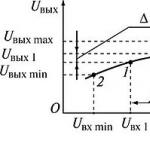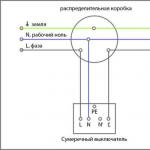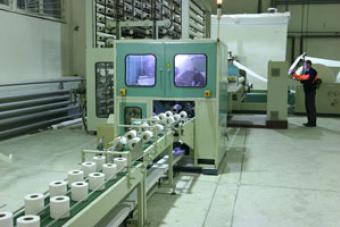Modern world dictates to us its conditions of existence, where there is no place for waste of energy resources. Therefore, the state annually raises tariffs for electricity and increases the coefficients of consumption standards for housing and communal services, in the absence of metering devices. But it is not enough to install it, it is important to know how to take readings from the electricity meter and transfer them correctly to your management company or power supply.
- Taking readings correctly
- Methods for transmitting evidence
What is a counter and what is it for?
The first devices in the world capable of taking into account the amount of electricity consumed appeared more than 100 years ago. But until a certain time they remained unclaimed, until there was a need to control the consumption of electricity.
Currently, a meter is not an easy device for commercial accounting of electricity consumption. Modern models are high-tech devices, with a large number of different functions.
In addition to their main purpose, such devices have the following features:
- Display current time, date.
- Kilowatts are counted in several modes.
- Can remember past readings.
- Equipped with informative LCD displays.
- Automatically transfer readings to the service organization.
Classification of electricity meters
And now, let's look at the main types of counters, their differences.
According to the principle of work, they are divided into the following types:
- Mechanical (induction). The vast majority of such devices are equipped with a disk, the rotation of which indicates the intensity of electricity consumption. But they have a large error, low reliability, and are also inconvenient to install and operate. Therefore, they are gradually leaving the market, giving up their positions to more sophisticated "brothers".
- Electronic. On early models of these devices, the indication of readings remains mechanical (rotating drums). For this reason, such counters are much cheaper. Later modifications have a liquid crystal display on board, which allows you to implement additional functions. The main filling modern appliances accounting is an electronic board.
The most interesting classification of electronic meters is the ability to account for electricity at certain intervals. To facilitate understanding, we will analyze each of the subspecies separately:
- One-rate. Everything is simple here. The device counts the total amount of electricity, which is paid at the usual rate. As a rule, they do not have any other functions.
- Two-tariff. Such models keep records of consumption at different times, during the day from 7:00 to 23:00 and at night from 23:00 to 7:00. For each of these periods, different payment rates apply. Basically, at night, the cost of a kilowatt is 70% cheaper. On the territory of Russia - this is the most common type of electricity meters.
- Three-tariff. It's a little more complicated here. The night period is the same
from 23:00 to 07:00. The daily rate is valid from 10:00 to 17:00 and from 21:00 to 23:00. And there is also an intermediate period when consumption in the general network increases - from 7:00 to 10:00 and from 17:00 to 21:00. To unload the power grid, the cost of such a tariff is higher than usual.
Thus, people are encouraged to redistribute energy consumption, avoiding its spikes. You can, for example, wash and iron all night, and get ready for work two hours early. So the state "takes care" of its citizens.
To save on electricity bills, our readers recommend the Electricity Saving Box. Monthly payments will be 30-50% less than they were before using the saver. It removes the reactive component from the network, as a result of which the load and, as a result, the current consumption are reduced. Electrical appliances consume less electricity, reducing the cost of its payment.
- Single phase. This means that the wiring has one phase, that is, "+". In a similar way, most metering devices are mounted in city apartments and private houses, with low power consumption, up to 10 kW.
- Three-phase. In this case, the line has three phases. This is done in order to divide consumption into zones (one is light, the other is sockets, the third is something else) or you can use one meter for different rooms. Most often they are installed on the territory of cottage settlements.
This scheme allows you to connect energy-intensive devices with a voltage of 380 V (machines, powerful engines, welders etc.) and withstand an increased total load (industrial enterprises, common household appliances, etc.). In living quarters three-phase connection less commonly used, as it implies the presence of its own transformer.
Taking readings correctly
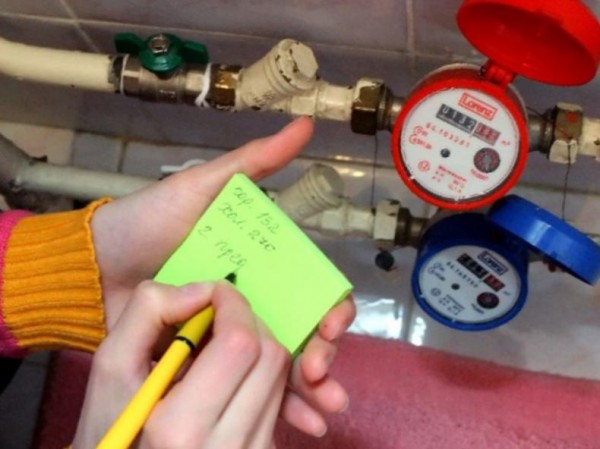 Well, with the theory sort of figured out, it's time to move on to practice. According to the law, owners with individual appliances accounting, are obliged to take and transfer evidence from them in a timely manner. This is done on a certain day of each month. Typically, management companies recommend providing readings closer to the end of the billing period.
Well, with the theory sort of figured out, it's time to move on to practice. According to the law, owners with individual appliances accounting, are obliged to take and transfer evidence from them in a timely manner. This is done on a certain day of each month. Typically, management companies recommend providing readings closer to the end of the billing period.
Also, the owners are required to periodically allow representatives of the management company to the devices (at least once every six months) to perform preventive maintenance.
Tip: do not be late with the transfer of testimony, otherwise you will have to pay according to the standard for this month!
Detailed instructions for taking readings:
- To get started, “arm yourself” with a piece of paper (receipt) and a pen.
- Then locate the counter.
- Visually make sure that the device is in good condition and working (the light is flashing, the disk is spinning, the integrity of the case and wires is not broken).
- Determine the operating mode of your meter (single or multi-tariff).
Remember: the owner of the premises is responsible for the safety and technical condition of the meters!
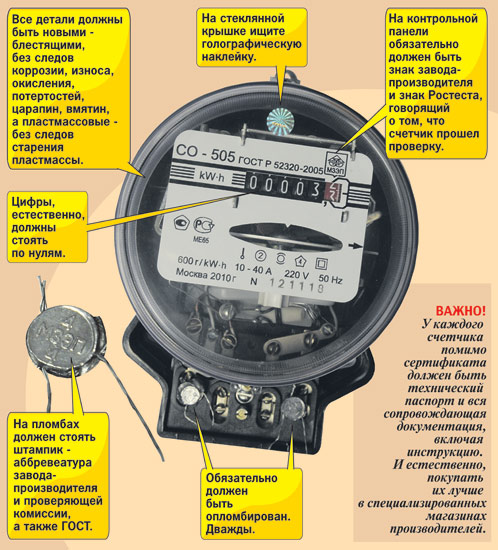
When buying, pay attention! Click to enlarge
How to take readings from the electricity meter: write down the three, four or five-digit number that is in front of the dot, comma or number of a different color (if any).
How to take readings from multi-tariff meter: if the device is in automatic mode, then at certain intervals, it will show the values of all tariffs - T1, T2, T3. If in manual, then by successive pressing of the "Enter" button, you should select the desired value. Then do the manipulations described for one tariff meter.
- Submit the readings taken to the management company.
Methods for transmitting evidence
First you need to correctly calculate the amount of electricity consumed per month. To do this, you need to subtract from what you wrote down the readings of the previous month. The resulting difference will be the desired value. For example, you wrote down the number 2456 kW, and last month it was 2130, the difference is 326 kW. Further, if necessary, we multiply this number by your tariff and get the amount to pay.
If your payment documents only provide for the recording of final readings, then no further calculations are needed.
There are several ways to convey the received values to the managing organization:
- Take the testimony personally, preferably on the same day to the branch of the company or pay the receipt.
- Through Personal Area owner, on the company's website, to transfer new testimony.
- If you have a meter capable of transmitting data on its own, you do not need to do anything.
It turns out that the whole procedure is not so complicated. Usually, after installing a new meter, the master should explain how to use it. You can also look at the instructions, which indicate the main characteristics and the necessary indicators. It is worth delving into all the subtleties once and the question will no longer arise - how to properly remove and transmit meter readings.
The Energomer CE-102 electric meter is a single-phase multi-tariff electricity meter that allows you to take readings at day / night tariffs. All information is displayed on the electronic scoreboard of the counter.
There are several varieties of Energy meters CE-102 and differ in the types of cases, if you look through the eyes of an ordinary ordinary user who has this meter installed in a house or apartment. Housing options are: S6, S7, R5 and R8.
Numerical variations of counter models 145, 245, 148, 248.
Viewing the display modes can be carried out both in automatic mode and in manual mode.
- In automatic mode, the data on the display are displayed sequentially and cyclically with a small interval.
- In manual mode, you need to use the control button to select the necessary information. Depending on the version of the model, to switch modes between indicators, there are buttons SHOT, or an optical button viewing [VIEW]. For convenience and quick search, all information on the Energomer CE-102 meter was divided into groups. Each group has its own indicators.
The transition between menu groups is carried out by long pressing the control button [SHOT] or [VIEW], and viewing the parameters within the group is performed by short pressing the same button.
The meter readings are recorded up to the comma sign.
Display modes for CE 102 meters in S6 and R5 cases
To take readings on these models, press the mechanical or optical button with long presses (hold for more than 3 seconds), view the information.
The first branch of values shows auxiliary parameters such as time, date, and so on.
Group 2 - general indications for all tariffs
To go to the next (2nd) navigation branch, press the [VIEW] button; the first value is the sum of current expenses (indicated by the letter T) at current rates (without clock and hammer and screwdriver icons). With a short press of the button, you can also view the amount at the end of the last month (1T), the month before last (2T) and finally 13 months ago (13T).
If we pay on a single-tariff plan:
We need the first value with the T sign to take readings write it down, if you pay at one tariff, then the mission is completed, the readings are recorded, in order to calculate the amount for payment, we multiply the recorded number by the rate for 1 kilowatt / hour.
If we pay on a two-tariff plan:
Group 3 - information on tariff 1 (day)
If we pay according to day/night tariffs, then from the second group, by long pressing the [VIEW] or [SHOT] button, we go to the next (3) branch of indicators - these are indicators for 1 tariff.
We see the first indicator with the icon T1 and kWh are the current total value of electricity consumption at tariff 1. Write this value.
Further, by short pressing the button, we, just like in the previous group, can view the following values at tariff 1:
- Expenses at the end of last month (icon 1T1)
- Consumption at the end of the month before last (icon 2T1)
- Consumption at the end of 13 months ago (icon 13T1).
Group 4 - information on tariff 2 (night)
Let's move on to the group of indicators (4) - these are consumption indicators for tariff 2.
The first value is the sum of the total expense for tariff 2. (icon T2). Write down the value.
As in the previous group, by briefly pressing the [VIEW] or [FRAME] button, we can view the costs for tariff 2
- at the end of last month (1T2)
- at the end of the month before last (icon 2T2)
- at the end of 13 months ago (badge 13T2).
We calculate the amount due
If you have a two-tariff payment system, you pay according to T1 values - expenses in daytime. and the value of T2 - expenses at night. To calculate the total amount of payment for electricity (light)
1) take the number T1 and multiply it by the rate for 1 kilowatt / hour in the daytime.
2) We take the number T2 and multiply by the cost of 1 kilowatt / hour at night.
3) Add up the resulting numbers.
If you have more than 2 tariffs such as day, peak, semi-peak, go to the next group of T3 indicators and write down the first number with the T3 icon. And we consider multiplying by the rate per kilowatt at the rate of 3.
For CE 102 meters in S7 and R8 cases, the reading of indicators is identical to that in the above example. To take indicators, we perform the transition between menu groups by long pressing the control button (more than 2-3 seconds), look for the T1 icon, then T2 and write down the numerical values.
We hope that we have explained in detail the process of taking readings from the Energomer CE-102 meter and our article will greatly facilitate this process. But if you want to study this model in more depth, then we attach instructions to the article.
Video review of the energy meter Energomer SE-102
If you go into any residential building, then you can find a special metering device there, which allows you to control the consumed electricity. The legislation in force in our country establishes that each owner must regularly pay money for the consumed electricity. Moreover, he must perform this procedure on his own every month. And for this you need to remove meter readings, and it is best if this operation is done every month on the same day.
In some cases, instead of the traditional location of the electric meter, which is the landing, it can be taken directly to the apartment or a private house. In such cases, you will be required provide free access to it to employees of the power supply organization who have the right to come with a check every six months. If the representative has any doubts that the data you provide are reliable, you must, upon first request, provide access to the meter, so that the employee has the opportunity to record the readings of the electricity meter.
Payment for services for the provision of electricity requires taking meter readings and calculating the number of kilowatt-hours consumed.
If an old-style induction type device is installed in the house, then you will need to write out all 5 digits up to the decimal point, which are shown on the scoreboard. It should be clearly understood that the symbols after the decimal point correspond to fractions of a kilowatt, which are indicated as tenths. Usually for them, a special allocation is used- red frame. However, focus on them should not be.
The main number read from the device will allow you to understand what the total electricity consumption was for the reporting period.
The very procedure for calculating the number of kilowatts spent by the owner over the past month is quite simple and consists of the following.
From the data taken from the electric meter, the indicators for the last month are subtracted. The result of this operation will be the number of kilowatt-hours that were used in the current month.
How much to pay?
Having an idea of how to take readings from an electricity meter, it will not hurt the owner to get acquainted with the scheme for calculating the amount payable for electricity. This is done as follows: the calculated number of kilowatts is multiplied with the price, according to the current tariff.
It is important to keep in mind that different tariffs will be used for each specific territory. And rates for rural areas will be different from the tariffs used in cities. It is also necessary to take into account the devices used in an apartment or a private house. For example, if the owner uses an electric stove, then he will have to pay more for electricity than a person who cooks on gas.
The disk counter allows you to find out other parameters, since when making one revolution with the disk, you can say that 600 or 1200 were consumed, which is equivalent to one kilowatt.
We take readings from a multi-tariff meter
We are talking about a new class of metering devices, using which the owner can receive up-to-date data on electricity consumption displayed on a digital display. It is worth saying that these devices can provide not only information about the current time and load. Among their possibilities there is a separate accounting of the spent electricity depending on the specific time of day.
Therefore, with proper use of such a meter, the owner can minimize his energy costs, thereby avoiding unnecessary overpayment. The information displayed on the electronic scoreboard contains many numbers, but only a few are required to take readings. And although these data may not match. due to differences in the device, the data capture scheme in each case will be similar.
How to correctly take readings of the electric meter?
For this you will need a pen and paper. A flashlight may also be required if necessary. Approaching the counter, you will see on the display a burning letter “T” with numbers from 1 to 3. To select the required tariff, there is an “enter” button. After that, you need to record the following data:
The procedure for calculating the exact number of kilowatt-hours consumed over a time period has its own characteristics.
- First, the value obtained for the previous period is subtracted from the current readings, in accordance with the above scheme.
- Further the calculated total must be multiplied by the tariff, which operate in your territory, corresponding to one kilowatt-hour.
- By adding the totals, the amount will be obtained, which will have to be paid for the last period.
In this way, the readings of the electricity meter are taken.
Features of other metering devices
If you are using a two-tariff meter, then it will be useful for you to know not only how to correctly take readings of the electricity meter, but also its operating modes:
- T1 corresponds to the time interval from 7 am to 11 pm;
- T2 - the rest of the time interval, between the specified hours.
In the case of using a three-tariff meter, the following features will be provided for it:
- T2 (preferential tariff), which corresponds to the time regime from 23 pm to 7 am;
- T3 corresponds to the preferential regime, for which there are two time periods: from 10 am to 5 pm and from 9 pm to 11 pm.
- T1 corresponds to the peak period, during which the highest tariff for the consumed electricity is applied.
Conclusion
Electric meters simplify the procedure for accounting for electricity consumption, so that each owner has the opportunity to independently determine the number of kilowatt-hours used and the amount payable for them. It is important to know how to take readings from the electric meter. This is done quite simply, although in some cases it may be difficult if you have a new type of electricity meter installed. However, the principle of determining the number of kilowatt-hours that were consumed over the past reporting period does not have any particular differences.
If necessary employees of the power supply organization can advise you about this question. The main thing is to tell them which model of the electric meter is installed in your house and after that you will be able to independently take readings and pay for the consumed electricity.
For monthly payment for consumed electricity, it is necessary to transfer data to the subscriber service or independently carry out calculations. In any case, it is necessary to take the readings of the electricity meter, and then take the appropriate actions. How to do this - consider further.
We take readings from induction meters
Induction meters can be distinguished by a spinning wheel, which is located just below the frame with numbers. These numbers are the meter readings. The number of digits depends on the model.
How to take readings of an inductive and electronic electricity meter
How many digits to write off
Usually there are 5, 6 or 7 digits on the induction meter display. In most cases, the last digit, less often two, are separated by a comma, color, or differ in size. All numbers after the decimal point are not taken into account when taking readings. They show tenths and hundredths of a kilowatt and should not be taken into account. That is, all numbers after the decimal point are not taken into account.
There are models with three digits "significant" and two after the decimal point
But it is worth remembering that there are models of counters in which there is no comma. In this case, when taking readings, it is necessary to write off all the numbers. If this is not done, sooner or later you will have to pay the difference, and it usually turns out to be sooo big. So be careful.
If you are not sure if your meter has a comma, write off the model, name and call the subscriber service of the electricity supplier. Let them clarify how many digits in your case need to be written off when taking readings. You can also call the controller to the house or clarify these data with the electrician of the management company.
How to shoot
Immediately after installing the meter, you were given an act in which the initial numbers are indicated. When it comes to take the readings of the light meter, take a piece of paper, rewrite there the readings that are currently available (excluding the numbers separated by a comma). You can also not rewrite the zeros that are at the beginning - up to the first digit (see photo).

For further calculations, data for the previous month is required. In the first month of use, you take them from the installation certificate, and in the future you either need to keep receipts or keep a log book. Where and how they will be stored is your choice.
Some subscriber services work in such a way that you don’t even need to count anything, you just need to transfer data at a certain period of time. Their automated system she will write it to your personal account (or the operator will do it), then she will make the accruals on her own and generate a receipt. You will only have to pay the invoice. But even in this case, for control, you can consider how much you have to pay for electricity on your own. Of course, it is unlikely that computers will make a mistake (they think), but you never know ...
How to count
For example, consider the readings in the photo above. Let the previous ones be 4852, the current ones 5101 (we ignore the numbers after the decimal point). We consider the power consumption: 5101 - 4852 = 249 kW. To find out how much you have to pay, you need to multiply the received number of kilowatts (in this case, 249 kW) by the tariff. Get the amount that you have to pay for the light.
If the counter is standing for a long time, sooner or later it will “reset” - zeros will appear in the first positions. How to calculate the electricity consumption in this case? Everything is very simple. This time, you will have to rewrite the readings with all zeros, and put “1” in front of the first. For example, you sewed to take readings from the counter, and there only the last digits are different from zero. Or, as in the photo below, it costs only one.

After zeroing, there may be such a picture, or there may be two digits other than zero, or three ...
Rewrite the value as it is, with all zeros (but do not write the numbers after the decimal point), put one before the first zero, and then count as before. Let's count the readings in the photo. We write off the reading by putting “1” in front: 100001. Let the last readings be 99863. Subtract 100001 - 99863 = 138 kW. Total consumption for the reporting period amounted to 138 kW. In the future, write off the readings of the electric meter as before, without leading zeros and without substituting a unit.
Readings of electronic electricity meters
In electronic electricity meters, not a mechanical display with "jumping" numbers, but an electronic one is installed. It can display not only numbers showing how many kilowatts have been spent, but also the date, meter operation time, and some other data. In most electronic light meters, these data change each other after a few seconds. If the meter is multi-zone, readings for each zone (T1, T2, T3, T4) are sequentially displayed.
To take readings of an electronic type electricity meter, you can wait until the necessary information appears and write it off. The second option is to press the enter button. You may have to click more than once - until the necessary information appears. It can be identified by the icons that appear on the screen. Usually this is T1, T2, T3, T4 or the word TOTAL.
For example, in the photo below, on the screen in the upper left corner we see the T1 icon and a little further on the larger numbers - 72.69. If you look closely, there are units of measurement behind them - kWh. This is the consumed electricity in the first zone T1 (daily tariff).
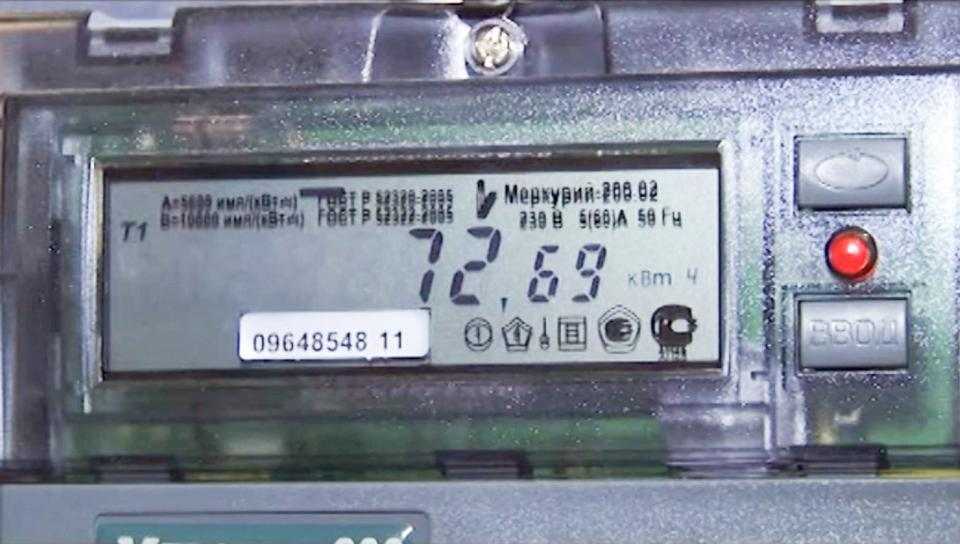
An example of an electronic meter reading
After the necessary data has been displayed, they are recorded in the receipt and then the calculations are carried out (described above). If the data just needs to be transferred to the subscriber service, they can be written down on a piece of paper.
Be careful! Here, too, it is necessary to rewrite only the whole part, ignoring the decimal places. For example, in this case (in the photo above), it is necessary to transfer or carry out calculations only with the number 72 without a “tail”.
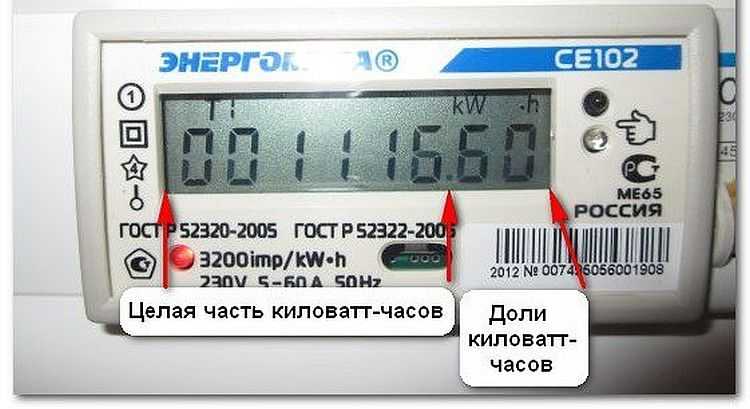
How to take readings from a Mercury 200 meter
There are single-rate Mercury meters (in the specification they are designated as 200.00), and multi-tariff meters (with numbers after the dot other than zero, for example, Mercury 200 01, it can also be 02 or 03). They differ in the number of zones, as well as the presence / absence of a control panel.
Regardless of the model, readings are taken in the same way. You just have to press the “enter” button a different number of times or wait for more numbers to appear.
Mercury 200 electric meters alternately show the time, date, then tariffs for zones. First, the time is displayed in the usual tariff - hours, minutes, seconds are shown a little higher. Then, after a few seconds, the date appears on the screen. It is also displayed in the standard format: day, month, year.

After that, the display of tariffs starts. The name of the tariff appears in the upper left corner: T1, T2, T3 or T4. Their number depends on the model you have installed. They all light up one by one. At this stage, they can be written (the whole part, without decimal places).
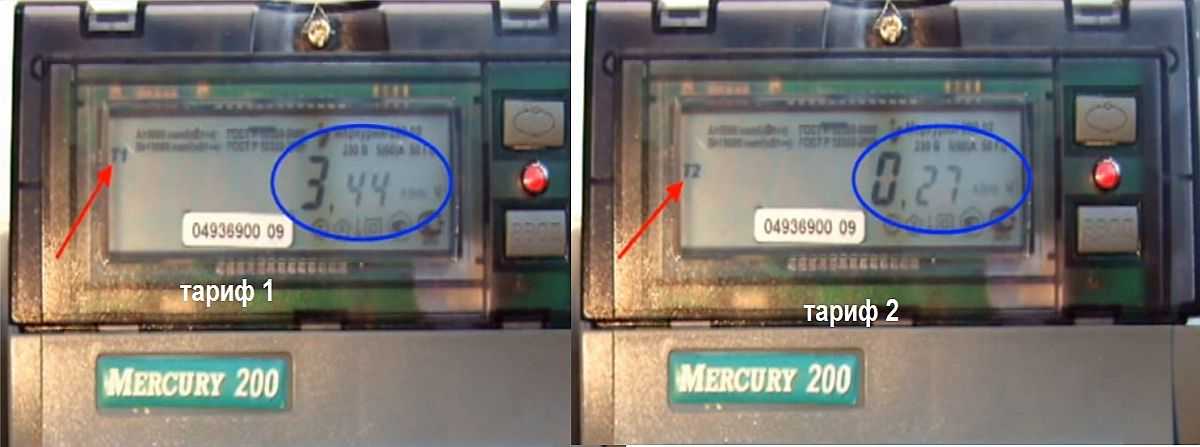
After all tariffs, a checksum of all tariffs appears. Then the cycle repeats - time, date, tariffs, total value, etc.
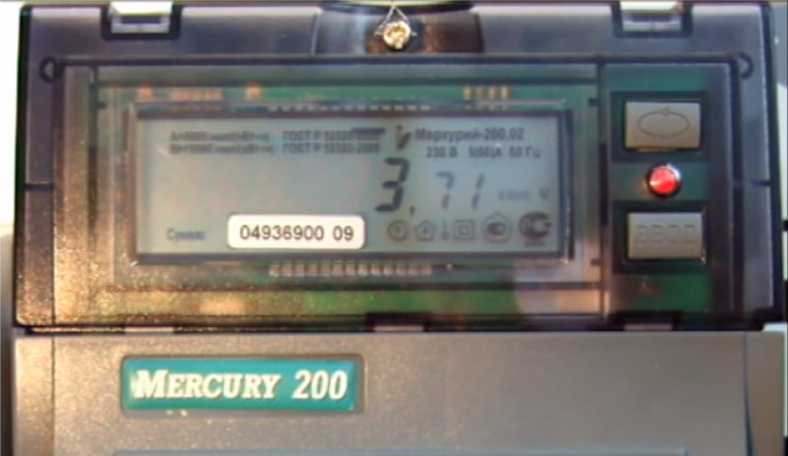
The numbers on the screen change every 5-10 seconds, depending on the setting. You might as well write it down. But if you didn’t have time, you can switch to tariffs in manual mode. To do this, at any time press the "enter" button. In the photo it is under the red LED. Press the button (pressed / released) until the value you require appears. To switch to the next, click again. Quite easy.
It will be a little more difficult with the calculations, since you will have to calculate the number of kilowatts consumed for each zone. This is where all the difficulties end. You now know how to take readings of a multi-tariff electricity meter. All other models of Mercury meters are not much different in this regard. Even their buttons look the same and are located in the same place.
Energy meters
Taking readings from the energy meter of the Energomer day-night (two-tariff or multi-tariff) occurs in the same way. The difference is that the button on these electricity meters is called "PRSM" (view). There can be two or three buttons - depending on the modification.
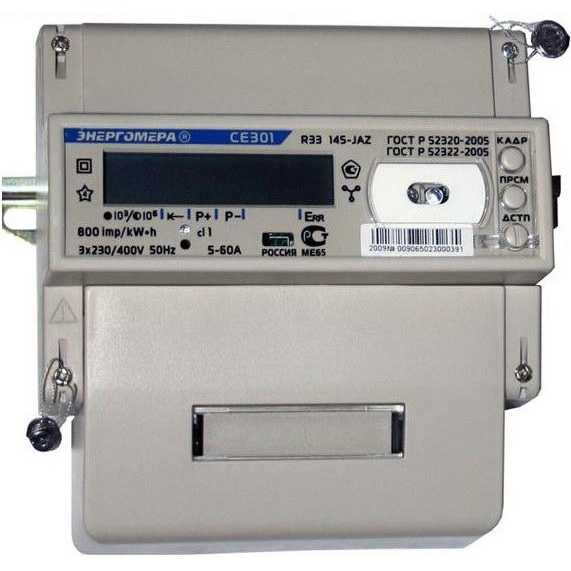
When you click on this button, numbers appear showing how many kilowatts have been “winded up” for each tariff zone. There are no more differences.
Take readings from the Micron electricity meter
In multi-tariff electronic electricity meters Mikron, there is only one button on the case, and you must press it to display the required readings on the screen. Only in this case, you need to wait until the display shows “checkmarks” above the letters “T1” and “R +” (see photo). This will be the first rate.
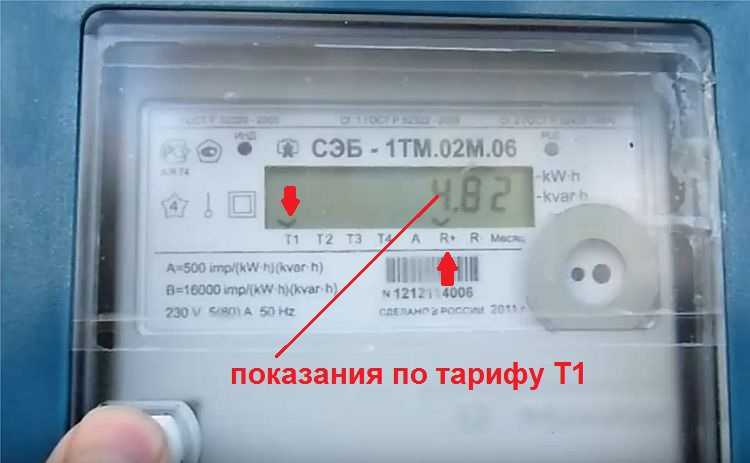
How to take readings from the electric meter Micron model SEB-1TM.02M
Then click on the same button until the checkmarks appear above T2 and R +, if there are more zones, click on. This is how the readings are taken from this counter day / night.
Saiman counters
Now in many regions old induction meters are replaced with electronic ones for free and most often they install Saivan devices. These are very simple devices, they do not have buttons with which you can forcefully “flip through” the readings. You just have to wait until the required value is displayed. That is, in this case, take the readings of the electricity meter - just wait until the required value (TOTAL) is displayed and write it down on the receipt (or transfer it to the appropriate service).
To make it easier to navigate, here is the order in which the data is displayed in this electric meter:
- date of;
- time;
- counter number;
- gear ratio (1600);
- TOTAL - readings of a single-tariff meter or are displayed sequentially T1, T2, TOTAL for counters of the day / night type (two-tariff).
It is necessary to write down the readings of TOTAL or T1 and T2 in the receipt, as well as the total TOTAL. Let us remind you once again that you need to write down only the whole part, without taking into account the numbers after the decimal point. You can watch the same information in video format.
Meters with automatic data transfer
Many instrument manufacturers electrical energy produce models that transmit readings via a specially organized channel in automatic mode. Installing and configuring this equipment is a more complicated process, but you will not have to worry about how to transfer the readings of the electricity meter. They "leave" themselves.
How to take readings from three-phase meters
There are two types of three-phase electricity meters - the old type, requiring transformers and electronic direct connection (without transformers). If an electronic one is installed, it is necessary to take the readings of the electricity meter in the same way as described above. Simply write down the values, wait until the desired information is displayed on the screen or “flip through” the data to the required page.

If a large power is allocated or there is an old-style meter, a transformer is installed on each of the phases. To take readings in this case, you need to know the transformation ratio. Taken readings must be multiplied by this factor. The resulting figure will be the actual expense.
But in general, you need to read the contract. The calculation procedure should be prescribed there - in some organizations they write out readings, put down the transformer data or the transformation ratio below, and the operator himself makes the actual calculations. So if you have a 3-phase meter, specify the form and procedure for calculations when installing and sealing the metering device and putting it into operation.
Some "craftsmen" make the electric meter spin in the opposite direction. Saving money. And there is a real legal way savings using the same meter. Recently, new houses at the construction stage are equipped with multi-tariff electricity meters. One of the tasks of such electricity meters is to save financial costs residents. Statistics for Moscow showed that owners of multi-tariff electricity meters save over 25% of the previous amount of paid bills. Many residents of old houses would also like to install new meters, but fear that they will not be able to take readings from such devices. One kind of electronic display frightens them. Others have got used to it and call the new device - "day-night counter". It is necessary to tell how to take readings of the electricity meter day and night.
Before purchasing a multi-tariff electricity meter, it is necessary to find out from the housing and communal services organization how many zones the day is divided into in the local power grid. The day can be divided into 2 or 3 zones. When divided into 2 zones, there is a T1 zone (day) and a T2 zone (night). When divided into 3 zones, there is a T2 zone (night), a T1 zone (peak), a T3 zone (semi-peak). Each zone has a separate tariff. Also, tariffs vary by the presence of a gas or electric stove. In the same housing and communal services organization, you can find out all the tariffs. In the same place, be sure to find out the payment codes for each zone. They must be included on the invoice.
According to the information received, you need to purchase a three-tariff or two-tariff meter. In no case should you connect the electric meter yourself. To do this, you will have to invite a specialist. And he should be asked to set the device not in automatic mode, but in manual mode. The fact is that if the counter works in automatic mode, the numbers on the display will change every 30 seconds. Older people may not have time to write them down on paper. It may seem that two-rate counter more convenient - fewer numbers. But don't be afraid of the numbers. Everything is very simple.
When the meter is in manual mode, the display will show the letter T with a number from 1 to 3. This number will correspond to the time of day when the meter reading is taken (see point 2). The indication should be recorded. Then press the "enter" button, the number will change, for example, it was T2, it will become T3. Record again. Press the button again, the word Amount or the corresponding icon will appear. Record the reading. Press the button again, T1 will appear. Record the reading. There will be no other signs, only T1, T2, T3 and Sum. The cost of electricity consumption for each zone is obtained by multiplying the tariff of the zone by the number of kWh in this zone. The total amount is obtained by adding the three zone costs. It remains to fill out a receipt for electricity, take it to the savings bank and pay. And live on, now knowing when to turn on washing machine or dishwasher.

